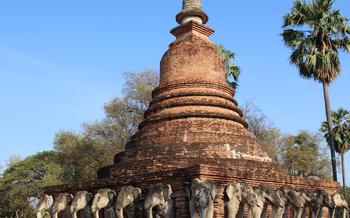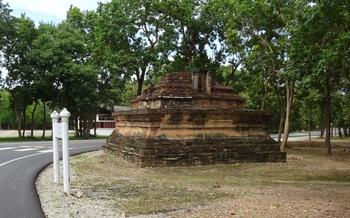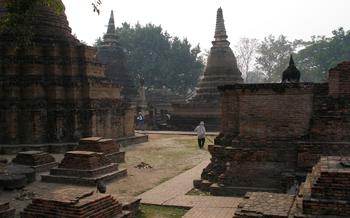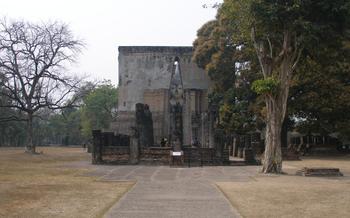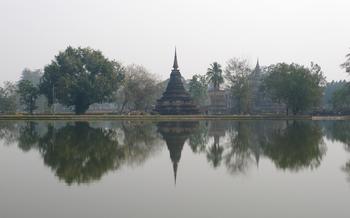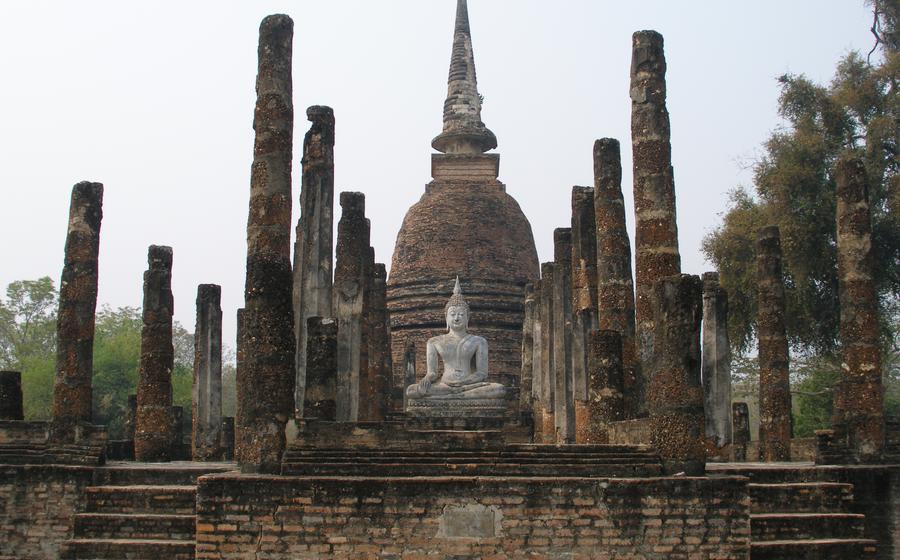
Wat Sa Si
- Historical Significance
- Temple Layout
- Mural Paintings: A Visual Tapestry of Buddhist Tales
- Viharn
- Chedi: A Symbol of Sacredness and Remembrance
- Monastery Grounds
- Local Culture
- Nearby Attractions
- Accommodation and Dining
- Ethical Tourism
- Photography Tips
- Insider Tip
Historical Significance
Sukhothai, the ancient capital of the Sukhothai Kingdom, holds immense historical significance in Thailand. Wat Sa Si, a magnificent temple complex nestled within this historic city, stands as a testament to the kingdom's rich cultural and religious heritage.
The Sukhothai Kingdom, established in the 13th century, played a crucial role in shaping the identity and culture of Thailand. It was during this period that Theravada Buddhism became the dominant religion, leaving an indelible mark on the nation's spiritual and artistic traditions. Wat Sa Si, built in the 14th century, embodies this deep-rooted Buddhist influence and serves as a living reminder of the kingdom's religious fervor.
The temple complex, with its intricate architecture, stunning Buddha images, and vibrant murals, offers a glimpse into the artistic and spiritual achievements of the Sukhothai era. Its well-preserved state allows visitors to immerse themselves in the kingdom's glorious past and appreciate the enduring legacy of its cultural heritage.
Temple Layout
The temple complex of Wat Sa Si is a testament to the architectural and artistic prowess of the Sukhothai Kingdom. The overall layout of the temple is symmetrical and well-organized, with the main structures arranged along a central axis. The ordination hall (ubosot), the viharn, and the chedi are the three primary structures that dominate the complex.
The ordination hall, located at the heart of the temple, is a rectangular building with a steeply pitched roof and elaborate gable ends. Inside, the hall is adorned with intricate murals depicting scenes from the life of Buddha and Jataka tales. The viharn, a multi-purpose hall, is situated opposite the ordination hall. It serves as a place for meditation, chanting, and teaching. The viharn's interior is characterized by a series of Buddha images enshrined in niches along the walls.
The chedi, a tall, spire-like structure, stands majestically at the rear of the temple complex. It houses sacred relics and symbolizes the Buddha's attainment of enlightenment. The chedi is surrounded by a circumambulation path, allowing devotees to walk around it as a form of meditation and devotion.
Each structure within the temple complex holds unique significance and contributes to the overall religious and spiritual experience of Wat Sa Si. The layout of the temple reflects the principles of symmetry, balance, and harmony, creating a serene and contemplative atmosphere for visitors to explore and appreciate.
Mural Paintings: A Visual Tapestry of Buddhist Tales
Wat Sa Si is renowned for its stunning mural paintings that adorn the walls of its structures, particularly the ordination hall and viharn. These murals are not merely decorative but serve as a visual narrative of Buddhist teachings and stories. Created using traditional techniques and natural pigments, the murals depict scenes from the Jataka tales, which recount the previous lives of the Buddha.
The Jataka tales are a collection of over 500 stories that showcase the Buddha's virtues, such as compassion, generosity, and wisdom. These stories are illustrated in vibrant colors and intricate details, capturing the essence of each tale. The murals at Wat Sa Si bring these stories to life, allowing visitors to immerse themselves in the teachings of the Buddha.
One of the most striking murals depicts the story of the Buddha's last life as Prince Siddhartha. It portrays his journey from a royal palace to a life of renunciation and enlightenment. Another mural illustrates the story of the Monkey King, who sacrificed himself to save his fellow monkeys from a fire, symbolizing the Buddha's selfless nature.
These murals are not just works of art but also powerful teaching tools. They convey the Buddha's teachings in a visually engaging manner, making them accessible to people from all walks of life. As visitors admire these murals, they are reminded of the Buddha's compassion and the importance of leading a virtuous life.
Viharn
Within the sacred grounds of Wat Sa Si, nestled amidst the lush greenery, stands the viharn, a multi-purpose hall that serves as a central gathering place for the monastic community and devotees. This versatile structure, also known as a sim, plays a crucial role in various religious activities and daily life at the temple.
The viharn is a rectangular building with a distinctive architectural style that blends traditional Thai elements with unique regional influences. Its elegant roof, adorned with intricate gable decorations and sweeping eaves, adds to its visual appeal. The hall's interior is equally impressive, featuring a spacious layout that accommodates both communal gatherings and individual contemplation.
As you step inside the viharn, a sense of tranquility envelops you. The air is filled with the gentle murmur of prayers and the rhythmic chanting of monks. The walls are adorned with vibrant murals depicting scenes from the life of Buddha and Jataka tales, narrating stories of his previous lives and teachings. These exquisite paintings serve as a visual guide, reminding visitors of the principles of compassion, wisdom, and enlightenment.
The viharn is not just a place of worship but also a center for learning and community engagement. Monks gather here to conduct meditation sessions, chanting ceremonies, and Dharma teachings, sharing their knowledge and wisdom with the local community. Devotees come to the viharn to pay homage to Buddha, seek blessings, and participate in religious rituals.
Whether you are a devout Buddhist, a history enthusiast, or simply someone seeking a moment of peace and reflection, the viharn at Wat Sa Si offers a rich and rewarding experience. As you sit in silent contemplation or join the monks in their daily prayers, you will feel a deep connection to the spiritual essence of this sacred place.
Chedi: A Symbol of Sacredness and Remembrance
The chedi at Wat Sa Si stands tall and majestic, symbolizing the sacredness and eternity of the Buddha's teachings. Built in the classic Thai style, the chedi features a graceful bell-shaped base that tapers into a slender spire, adorned with intricate carvings and decorative elements.
At the base of the chedi, visitors can observe a series of niches housing Buddha images in various postures and mudras, each representing a different aspect of the Buddha's life and teachings. These images add to the spiritual significance of the chedi, creating a sense of reverence and devotion.
Inside the chedi's hollow interior lies a hidden chamber, believed to house sacred relics or precious objects associated with the Buddha or important monks. These relics are often considered to possess spiritual power and are deeply revered by Buddhist devotees.
Legends and stories surround the chedi at Wat Sa Si, adding to its mystique and allure. One such legend tells of a miraculous event where the chedi's spire was struck by lightning but remained unscathed, symbolizing the enduring strength and resilience of the Buddha's teachings.
Visitors to Wat Sa Si are encouraged to pay their respects at the chedi, offering prayers, lighting incense, or simply taking a moment to reflect on the profound teachings and legacy of the Buddha. The chedi stands as a reminder of the impermanence of life and the eternal nature of the Buddha's wisdom, inspiring pilgrims and visitors alike.
Monastery Grounds
As you step into the monastery grounds of Wat Sa Si, a sense of tranquility envelops you. The lush vegetation, serene ponds, and towering trees create a peaceful oasis amidst the bustling city. The monastery exudes an aura of spirituality and devotion, inviting visitors to slow down and immerse themselves in the sacred atmosphere.
The grounds are home to a community of monks who dedicate their lives to meditation, study, and spiritual practice. Visitors are welcome to observe the monks' daily routines, which include chanting, meditation sessions, and alms-giving ceremonies. The monks' serene demeanor and unwavering dedication to their faith inspire a deep sense of respect and admiration.
One of the highlights of the monastery grounds is the meditation hall, where visitors can join the monks for guided meditation sessions. These sessions offer a unique opportunity to learn about Buddhist meditation practices and experience the inner peace and tranquility that meditation can bring.
As you wander through the grounds, take some time to appreciate the natural beauty that surrounds you. The lush gardens, adorned with colorful flowers and tropical plants, provide a vibrant contrast to the ancient temple structures. The serene ponds, reflecting the golden spires of the chedi, create a picturesque landscape that invites contemplation.
Whether you are seeking spiritual enlightenment, a moment of peace, or simply a chance to admire the beauty of nature, the monastery grounds of Wat Sa Si offer a truly enriching and memorable experience.
Local Culture
Wat Sa Si is deeply embedded in the local culture and traditions of Sukhothai. The temple serves as a hub for community gatherings, religious festivals, and ceremonies. During the annual Songkran festival, the temple grounds come alive with vibrant processions, water-throwing rituals, and merit-making activities. Locals and visitors alike flock to the temple to pay homage to the Buddha images, seek blessings from the monks, and participate in the festivities.
One remarkable tradition associated with Wat Sa Si is the biannual robe-weaving ceremony. This elaborate ritual involves the entire community coming together to weave new robes for the Buddha images. The robes are adorned with intricate designs and patterns, symbolizing the collective devotion and craftsmanship of the Sukhothai people. The robes are then ceremoniously presented to the monks during a special blessing ceremony, further strengthening the bond between the temple and the community.
Stories and legends abound about the temple's miraculous powers and the blessings it has bestowed upon the local people. Devotees often share tales of answered prayers, divine interventions, and spiritual awakenings experienced within the temple grounds. These stories are passed down through generations, reinforcing the deep reverence and faith that the local community holds for Wat Sa Si.
Preserving and promoting the local cultural heritage is of utmost importance to the people of Sukhothai. Wat Sa Si plays a crucial role in this endeavor, as it serves as a living testament to the artistry, craftsmanship, and spiritual traditions of the Sukhothai Kingdom. The temple's ongoing restoration and maintenance efforts are a testament to the community's commitment to safeguarding this invaluable cultural asset for future generations.
Nearby Attractions
Beyond the captivating allure of Wat Sa Si, Sukhothai offers an array of historical and cultural treasures waiting to be discovered. The ancient city is home to numerous other temples, each with its unique charm and significance. Among these, the majestic Wat Mahathat, with its towering chedi and intricate carvings, stands as a testament to the grandeur of the Sukhothai Kingdom.
For those seeking a glimpse into the region's past, the Sukhothai Historical Park is a must-visit. This UNESCO World Heritage Site encompasses the ruins of the old city, including ancient palaces, temples, and fortifications. Visitors can wander amidst these remnants of a bygone era, imagining the bustling life that once filled these spaces.
History buffs will also appreciate the Ramkhamhaeng National Museum, which houses a collection of artifacts and exhibits showcasing the rich cultural heritage of Sukhothai. From ancient pottery and sculptures to inscriptions and manuscripts, the museum offers a fascinating journey through the kingdom's past.
Nature enthusiasts can find respite in the Sri Satchanalai National Park, located just a short distance from Sukhothai. This stunning park boasts lush forests, cascading waterfalls, and an abundance of wildlife. Visitors can embark on hiking trails, spot exotic birds, and even encounter elephants in their natural habitat.
Whether you seek historical immersion, cultural exploration, or simply the tranquility of nature, Sukhothai offers a wealth of experiences beyond the walls of Wat Sa Si. Embrace the opportunity to delve deeper into this captivating region, uncovering its hidden gems and creating lasting memories.
Accommodation and Dining
When planning your visit to Wat Sa Si, you'll find a range of accommodation options to suit different budgets and preferences. For a truly immersive experience, consider staying in a traditional Thai-style guesthouse or homestay near the temple. These accommodations often offer a glimpse into local life and culture, with warm hospitality and delicious home-cooked meals.
For those seeking a more luxurious stay, there are several upscale hotels and resorts in the vicinity of Wat Sa Si. These establishments offer modern amenities, comfortable rooms, and often stunning views of the temple complex.
Sukhothai's culinary scene is a delight for food enthusiasts. From humble street stalls to renowned restaurants, there's something to satisfy every palate. Don't miss the chance to indulge in local specialties like khao soi, a rich coconut-based curry noodle soup, or pad thai, a stir-fried rice noodle dish with your choice of protein and vegetables.
If you're seeking vegetarian or vegan options, fear not. Sukhothai has a growing number of restaurants that cater to plant-based diets. From tofu-based curries to fresh salads and veggie-packed stir-fries, you'll find plenty of delicious choices to keep you energized throughout your temple explorations.
Ethical Tourism
As responsible travelers, it is essential to prioritize ethical tourism practices when visiting Wat Sa Si and other sacred sites in Thailand. Here are some tips to ensure your visit is respectful and sustainable:
-
Minimize your environmental impact: Reduce your carbon footprint by choosing sustainable transportation options, such as walking, biking, or using public transport. Avoid single-use plastics and bring your reusable water bottle to stay hydrated.
-
Support local businesses: Contribute to the local economy by purchasing souvenirs and handicrafts from local vendors. Choose restaurants that use locally sourced ingredients and support community-based tourism initiatives.
-
Respect cultural and religious customs: Dress modestly and behave respectfully while visiting the temple. Refrain from making loud noises, pointing your feet at Buddha images, or touching the monks without permission.
-
Preserve the temple's heritage: Avoid climbing on ancient structures or touching the Buddha images. Refrain from graffiti or vandalism, and help preserve the temple's historical integrity for future generations.
By following these ethical tourism practices, you can contribute to the sustainability and preservation of Wat Sa Si while ensuring a meaningful and respectful travel experience.
Photography Tips
To capture the stunning beauty of Wat Sa Si through photography, consider the following tips:
-
Best Angles: Explore different angles to find unique perspectives. Photograph the temple from a distance to capture its grandeur, and move closer for intricate details. Experiment with low angles to emphasize the height of the chedi and ordination hall.
-
Lighting Conditions: Visit during the golden hours of sunrise and sunset for the most flattering light. The warm hues will enhance the temple's colors and create a magical atmosphere. Avoid harsh midday sun, which can result in overexposed images.
-
Camera Settings: Use a wide-angle lens to capture the temple's vastness. Adjust your aperture to control the depth of field, creating a blurred background to isolate the temple as the focal point. Experiment with shutter speed to capture movement, such as clouds passing by or monks walking through the grounds.
-
Post-Processing: Enhance your photos with post-processing techniques. Adjust the white balance to achieve accurate colors. Use tools to remove unwanted elements, such as tourists or wires, to create a clean composition. Experiment with contrast and saturation to bring out the vibrant hues of the temple.
Insider Tip
Beyond the main attractions of Wat Sa Si, there lies a hidden gem waiting to be discovered. Tucked away in a serene corner of the temple grounds is a small meditation garden, often overlooked by visitors. This tranquil oasis invites you to escape the hustle and bustle and find moments of solitude and reflection. Surrounded by lush greenery, the garden features a serene pond with blooming lotus flowers, creating a peaceful ambiance that encourages contemplation. As you sit in silence, listening to the gentle sounds of nature, you'll feel a sense of tranquility wash over you. Take this opportunity to connect with your inner self and find solace amidst the beauty of this hidden sanctuary.
